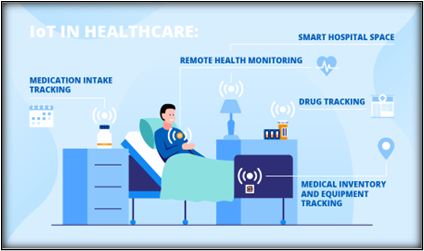An Enhanced Security Model for Protecting Data Transmission and Communication in Recent IoT Integrated Healthcare Industry Using Machine Learning Algorithm
Main Article Content
Abstract
Different kinds of security need to be applied to various application-centric IoT networks. Safety is one of the most important aspects to be considered regarding user, device, and data. The healthcare industry is a special IoT network fully connected with medical/healthcare IoT devices. The data generated from the IoT devices are transmitted or shared from one hospital to another through the Internet. Healthcare data has more private, medical, and insurance information that intruders can use on the Internet. The intruders misbehave with the patient or the general public registered in the healthcare industry. Some intruders blackmail the patient based on their private/personal information. Healthcare industries and their research team are trying to create a security framework to safeguard the data to avoid these malicious activities. This paper aims to secure and analyze healthcare IoT data using the Support Vector Machine algorithm. It learns the entire dataset, classifies it, and calls the encryption-decryption algorithms (RSA) to secure private data. The proposed SVM and the RSA algorithm are implemented in Python, and the results are verified. The performance of the proposed SVM-RSA is evaluated by comparing its results with the other algorithms.
Article Details
References
Mandula, K., Parupalli, R., Murty, C. A., Magesh, E., & Lunagariya, R. (2015, December). Mobile-based home automation using the Internet of Things (IoT). In 2015 International Conference on Control, Instrumentation, Communication and Computational Technologies (ICCICCT) (pp. 340-343). IEEE.
Farooq, M. U., Waseem, M., Mazhar, S., Khairi, A., & Kamal, T. (2015). A review ofthe Internet of Things (IoT). International journal of computer applications, 113(1), 1-7.
Kapoor, A., Bhat, S. I., Shidnal, S., & Mehra, A. (2016, October). Implementation of IoT (Internet of Things) and Image processing in smart agriculture. In 2016 International Conference on Computation System and Information Technology for Sustainable Solutions (CSITSS) (pp. 21-26). IEEE.
Alam, F., Mehmood, R., Katib, I., & Albeshri, A. (2016). Analysis of eight data mining algorithms for smarter Internet of Things (IoT). Procedia Computer Science, 98, 437-442.
Banica, L., Burtescu, E., & Enescu, F. (2017). The impact of internet-of-things in higher education. Scientific Bulletin-Economic Sciences, 16(1), 53-59.
Thakar, A. T., & Pandya, S. (2017, July). Survey of IoT enables healthcare devices. In 2017 International Conference on Computing Methodologies and Communication (ICCMC) (pp. 1087-1090). IEEE.
He, S., Cheng, B., Wang, H., Huang, Y., & Chen, J. (2017). Proactive personalized services through fog-cloud computing in large-scale IoT-based healthcare applications. China Communications, 14(11), 1-16.
Sunil Patil, Rakesh Saxena, Yogesh Pahariya. (2023). Performance Comparison of SRM, PMSM & BLDC Motor Drives via Experimentation in Laboratory for EV Application. International Journal of Intelligent Systems and Applications in Engineering, 11(2s), 405 –. Retrieved from https://ijisae.org/index.php/IJISAE/article/view/2736
Djenna, A., & Saïdouni, D. E. (2018, October). Cyber attacks classification in IoT-basedhealthcare infrastructure. In 2018 2nd Cyber Security in Networking Conference (CSNet) (pp. 1-4). IEEE.
Islam, S. R., Kwak, D., Kabir, M. H., Hossain, M., & Kwak, K. S. (2015). The Internet of things for health care: a comprehensive survey. IEEE Access, 3, 678-708.
Tyagi, S., Agarwal, A., & Maheshwari, P. (2016, January). A conceptual framework for IoT-based healthcare system using cloud computing. In 2016 6th International Conference-Cloud System and Big Data Engineering (Confluence) (pp. 503-507). IEEE.
Qi, J., Yang, P., Min, G., Amft, O., Dong, F., & Xu, L. (2017). Advanced Internet of things for personalized healthcare systems: A survey. Pervasive and Mobile Computing, 41, 132-149.
Christopher Davies, Matthew Martinez, Catalina Fernández, Ana Flores, Anders Pedersen. Applying Recommender Systems in Educational Platforms. Kuwait Journal of Machine Learning, 2(1). Retrieved from http://kuwaitjournals.com/index.php/kjml/article/view/171
Gopalan, S. S., Raza, A., & Almobaideen, W. (2021, March). IoT security in healthcare using AI: A survey. In 2020 International Conference on Communications, Signal Processing, and their Applications (ICCSPA) (pp. 1-6). IEEE.
Aktas, F., Ceken, C., & Erdemli, Y. E. (2018). IoT-based healthcare framework for biomedical applications. Journal of Medical and Biological Engineering, 38(6), 966-979.
Hou, J. L., & Yeh, K. H. (2015). Novel authentication schemes for IoT-based healthcare systems. International Journal of Distributed Sensor Networks, 11(11), 183659.

